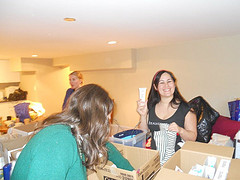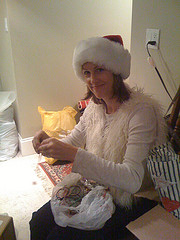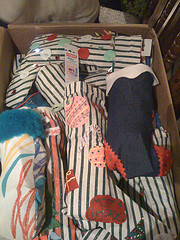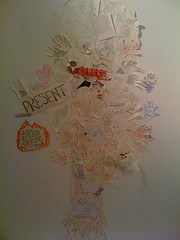Connecting Through Movement by Marlene Amado
The experiences of the first few years of life set the stage for how capable our immune systems are, how we cope with stress and even our ability to find meaning-worth, in our lives. Research that has emerged in psychophysical therapy and within Laban Movement Analysis supports “the interrelationships of anatomical functioning, personal feeling …and also with the awareness that movement both initiates and changes emotional feelings and about how we think…”[1] When the experiences of everyday life continue to be a place of struggle as well as living in poverty, where do you turn and who can you trust in a world that has placed you in a category that has no formal affiliation, but is set firmly at the margins of social welfare and wellness?
I had a first hand opportunity to join Caroline’s team of volunteers this Tuesday. Amongst the various services provided such as a hot meal, massage and beauty there was an area at the far end of the room designated for dancing. Music wafted from the boom box that rested on a worn piano. My favorite CD was No Doubt and later, some garage rock. The energy in the room was decidedly enthusiastic. There were smiles as the women were pampered and especially once I introduced myself. I teach pilates in Vancouver to a diverse group of people who can afford to willingly pay to be lead through a series of movements designed to help re-align the spine and correct poor movement patterns. This was a far cry from the usual demographic that I cater to. There is no lush flooring to sprawl on or high-end equipment on which to prop ourselves. My role was simply to invite some of the women up to move and dance to the music. Our goal was to offer the opportunity to move-without judgment and without set standards or expectations. What I saw was a very open group, and an accepting cohort of women. While I was unable to get everyone in the room to join the dancers at the front of the room, I noticed from those that were dancing, pure delight. There were many who, for personal reasons, did not get up and dance. One woman expressed how absurd it would be to get up and dance after the day she had had. After further inquiry she revealed to just having quit drugs.
When I think of connection in the body as I teach I am considering an individual’s relationship within and to her or himself. “To connect is to link, to establish communication… to associate mentally or emotionally”[2]. Considering the daily struggles these women experience that I take for granted, and the necessity of dis- associating oneself from inner/outer in order to survive, it is painfully obvious why so few feel compelled to join our group. Beauty Night is about offering a safe place where even the most seemingly frivolous approach to wellness is imagined and available. Perhaps my friend may not find it absurd to dance once she has successfully gotten through the hours that lead to another day without drugs. If she is not successful, I will still be there next week offering a safe space in which to move.
[1] Hackney, Peggy. Making Connections. Total Body Integration Through Bartenieff Fundamentals (New York: Routledge, 2002) 33.
[2] ibid. 233
About the Author:
Marlene Amado has been a certified pilates teacher since 2004 and has extensive experience as a movement teacher for over 15 years. Marlene completed her BA in Political Science at UBC in 2008 and continues to explore ideas on the body through various research and written publications. She is curious about new and various ways of teaching re patterning in the body as well as finding the deeper nuances of the pilates method. Marlene is committed to facilitating students’ empowerment and positive experience of self through movement. Marlene is a Pilates Alliance Member and is fully certified in all pilates apparatus equipment.











Thanks for sharing such a pleasant thought, piece of writing
is pleasant, thats why i have read it fully